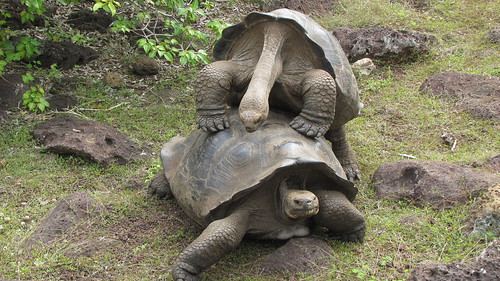
To walk from the Charles Darwin Research Station to the center of the town of Puerto Ayora, on Santa Cruz Island, simply follow the “T-Shirt Mile,” a sleepy stone road lined with dozens of souvenir shops. Mugs, onesies and shot glasses pay tribute the town’s only famous resident, a century-old giant tortoise named Lonesome George. My favorite shirt had a cartoon George in the center, with eyelash-batting lady tortoises on either side of him and one line at the bottom: Not So Lonesome George.
Before his unexpected death on June 24, George had certainly been with his share of females. But for the first 60-odd years of his life, he was the most awkward of virgins.
In 1971, a snail biologist working alone (which Galápagos researchers tend to do) found George on the uninhabited island of Pinta. The discovery was a big deal because scientists had previously assumed that George’s subspecies, Chelonoidis nigra abingdoni, had been killed off by sailors and whalers of centuries past.
George was sickly and thin, but gained weight quickly after researchers put him on a special diet. His anti-social behaviors were more difficult to fix. All tortoises are solitary, but unlike others, George didn’t even like sex. “He had no clue what to do with a female,” said one of our guides, Sofia. So experts at the Charles Darwin Research Station, where Sofia used to work, had to teach George some moves, she explained. “Um, what do you mean exactly?” some brave soul in our group asked. “Stimulation, that kind of thing,” Sofia answered, deadpan. Squelching any further questions, she added: “Eventually he learned the technique, and now he’s a pro.” The world’s most respected gigolo died 16 days later.
 After George’s initial discovery, researchers wasted no time in attempting to pimp him out. They scoured zoos around the world looking for suitable mates (and even offered a $10,000 reward, apparently). When they couldn’t find any Chelonoidis nigra abingdoni tortoises, they tried to pair George with related subspecies, figuring that preserving half of his DNA was better than none. Because George was originally found in Pinta, the northernmost island in the archipelago, researchers introduced him to females that came from the north. It didn’t work.
After George’s initial discovery, researchers wasted no time in attempting to pimp him out. They scoured zoos around the world looking for suitable mates (and even offered a $10,000 reward, apparently). When they couldn’t find any Chelonoidis nigra abingdoni tortoises, they tried to pair George with related subspecies, figuring that preserving half of his DNA was better than none. Because George was originally found in Pinta, the northernmost island in the archipelago, researchers introduced him to females that came from the north. It didn’t work.
DNA testing in the late 1990s turned up a surprise: George was most closely related to tortoises from the southern islands of Española and San Cristóbal. Nobody knows how his ancestors made their way so far north, but it was probably via ship (whalers often picked up tortoises as water sources). Based on this intel, researchers switched tactics, pairing George with females from the southern islands. They even tried in vitro fertilization, according to Sofia. Nothing worked, and now it’s too late.
Though he never passed on his genes, Lonesome George’s memorable name and ugly mug were a public relations goldmine. For 40 years, all of those magnets and keychains have been subtly spreading the message of conservation around the world. George’s death means the Galápagos Islands have lost an endemic subspecies, and that’s a shame. But the bigger tragedy may be the loss of an icon. Can the blue-footed booby step up? Perhaps. But judging from the t-shirts, I doubt it.
*
This is the fourth installment of a six-week series about my recent trip to the Galápagos. You can find the other posts here.
Photos by David Berkowitz and HelloTrade
Another great installment. Very humorous, despite the unfortunate ending. So glad we were able to see George before his passing. What to do with all the preprinted souvenirs?
Wait! Why is it too late?
Didn’t they freeze his sperm?
I’m pretty sure they froze his sperm, but it doesn’t do much good unless they can use it to make some kind of hybrid species. They tried in vitro fertilization while he was alive and it never worked…
Yeah, why haven’t they thought of this. I mean for humans for sure this will be an option. I just hope that they did this for animals too.
Here’s an excellent piece from Nature News about how scientists in the Galapagos are managing George’s death:
http://www.nature.com/news/the-legacy-of-lonesome-george-1.11017